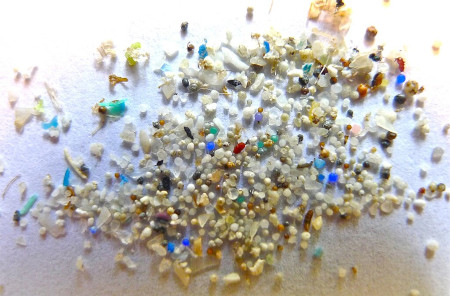

By Charles Gregoire
Our recent journey into understanding microplastic pollution began with a deep dive into our Climate Emergency Forum video on plastic pollution, Plastic Planet - Climate Chaos. The discussion highlighted just how pervasive microplastics have become in our daily lives.
We became much more aware of the unconscious choices we’d been making—especially in our use of dishwasher pods and compostable plastic bags.
Dishwasher Pods and Microplastics
We discovered that our dishwasher pods were PVA-based. Polyvinyl alcohol (PVA), commonly used in dishwasher and laundry pods, is a synthetic plastic that dissolves in water but does not fully biodegrade in most wastewater treatment plants or the natural environment. Up to 75% of PVA from these pods can pass through treatment and enter the environment as microplastics, contributing thousands of tons annually[2][18]. These microplastics accumulate in waterways, soil, and can even end up in our food and bodies.
Motivated by this, we researched alternatives and found a plant-based, biodegradable gel that avoids PVA and its associated microplastic pollution. While this switch brought up another consideration—the large plastic bottle the gel comes in—our region’s recycling system now accepts all types of plastic containers. As long as we rinse the bottle, it’s likely to be properly recycled, minimizing its impact compared to the persistent microplastics from detergent pods.
Dishwasher vs. Hand Washing: The Tradeoff
This research also led us to reconsider how we wash our dishes. Many people assume hand washing is greener, but studies show that modern ENERGY STAR dishwashers use as little as 3–5 gallons (11–19 liters) of water per cycle, while hand washing a full load can use 20–30 gallons (75–115 liters) or more, especially if the tap runs continuously[3][4][5][19]. Dishwashers are also more energy-efficient, heating only the water they use and operating at higher temperatures for improved cleaning and sanitation[3][4][5][20]. The Environmental Protection Agency notes that hand washing can use double the energy of a dishwasher[3]. For most households, using a modern dishwasher is both easier and more environmentally friendly, especially when run with full loads and eco-settings[3][4][5][20]. Hand washing can have a lower carbon footprint only if done extremely efficiently and with minimal water use[5][19].
Compostable Bags and Waste Management
Another part of our household waste routine is using 7.5 L compostable bags. Our region offers a program to divert household compostable materials from landfills using a brown bin. During winter, collection is reduced to once a month, which led to compost freezing and remaining in the bin during pickup. To address this, we started using compostable plastic bags.
However, we learned that while these bags are marketed as compostable, most are only truly compostable in industrial composting facilities—not in a typical backyard compost pile[6][7]. Home composting doesn’t reach the high temperatures or controlled conditions needed to break down bioplastics or many “compostable” bags[6][7]. Fortunately, our brown bin collection system provides access to industrial composting, so when we use compostable bags and place them in the brown bin, they are processed under the right conditions to fully break down. Our region also has specific guidelines: only certain types of compostable bags (like certified compostable cellophane or paper bags) are accepted in the brown bin, while conventional plastic and even some compostable plastics are not. This ensures the quality of the finished compost and prevents contamination. The bags we use comply with ASTM D6400 and CAN/BNQ 0017-088 requirements[8][21].
Microwave Popcorn and PFAS
During this process, we also made a surprising discovery about microwave popcorn. Many microwave popcorn bags are coated with plastics and chemicals known as PFAS (per- and polyfluoroalkyl substances), often called “forever chemicals” because they persist in the environment and our bodies for years. PFAS are added to popcorn bags to prevent oil from soaking through and to withstand high cooking temperatures. When the bag is heated, these chemicals can migrate into the popcorn itself. Studies show that people who regularly eat microwave popcorn have significantly higher levels of PFAS in their bodies—up to 63% higher than average[9][10][11]. PFAS exposure is linked to a range of health concerns, including high blood pressure, liver damage, reduced fertility, cancer, and immune system disruption[9][10][11].
In addition to PFAS, the plastic and chemical coatings on these bags can contribute to microplastic pollution. When heated, plastics can break down into microscopic particles that end up in our food and, eventually, our bodies. These microplastics are not biodegradable and accumulate in the environment, adding to the global microplastic crisis[10][14].
This discovery led us to rethink our snack choices. Instead of microwave popcorn, we now pop plain kernels on the stovetop, often with a little coconut oil.
Microwavable Rice Pouches and Microplastics
While writing this post, we also considered our use of microwavable rice pouches. We discovered that using these pouches, such as those from popular brands, also poses a microplastics and chemical exposure concern, especially when heated in a microwave. Recent research found that instant (pre-cooked) rice, including rice packaged in microwavable pouches, contains significantly higher levels of microplastics compared to uncooked rice. The study measured an average of 13 milligrams of plastic per serving of instant rice—about four times higher than regular rice. This contamination likely comes from both the processing and the packaging stages[12][13][14]. We plan to avoid this practice in the future and instead cook a week’s worth of rice on the stove, storing it in glass containers in the fridge.
Canned Foods and Microplastic Risks
Beyond packaging and processed foods, canned foods can also be a source of microplastic exposure. Recent studies have shown that a significant percentage of canned vegetarian foods—such as beans, chickpeas, and vegetables—can contain microplastics and plastic-related chemicals. These contaminants originate from both environmental pollution affecting crops and from plastic linings used in can manufacturing. Over time or when heated, these linings can degrade, releasing microplastics and chemical additives, such as bisphenol A (BPA), into the food. While many manufacturers have moved to BPA-free linings, the safety of some alternative coatings is not fully understood, and BPA as well as certain phthalates are known endocrine disruptors linked to reproductive, developmental, and metabolic health concerns.
Microplastics and phthalates can also enter canned foods during processing, as food comes into contact with plastic equipment, gloves, and packaging materials. Additionally, plants grown in contaminated soil or irrigated with water containing microplastics can absorb these particles, which may then end up in canned products. The health risks of ingesting microplastics are still being studied, but potential concerns include inflammation, immune disruption, and chemical exposure—especially from additives like BPA found in some can linings[23][24][25].
In summary, choosing dried beans over canned beans may reduce exposure to microplastics from packaging, but it does not eliminate microplastics entirely, as environmental contamination affects both forms.
Conclusion
These simple switches—choosing PVA-free dishwasher gels, using compostable bags correctly in industrial composting, and avoiding microwavable packaging—help eliminate exposure to PFAS and microplastics, reduce waste, and often save money. It’s a small but meaningful step toward personal health and environmental protection.
Making environmentally conscious choices often involves trade-offs and a good understanding of local waste management systems. By adopting these practices, we’re reducing our household’s microplastic, landfill, and water impacts. But it’s crucial to use compostable bags as intended—through industrial composting—since home composting won’t break them down effectively[6][7][8][21]. Our region’s blue bin and brown bin collections support these efforts, helping us move toward a healthier planet.
